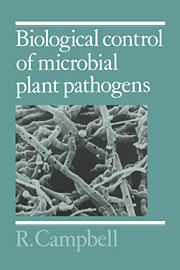Book contents
- Frontmatter
- Contents
- Preface
- 1 Introduction to plant pathology and microbial ecology
- 2 Historical and commercial background and methodology of biological control
- 3 Biocontrol on leaf surfaces
- 4 Biocontrol of stem diseases
- 5 Biocontrol of diseases of roots
- 6 Biocontrol of diseases of flowers and fruit
- 7 Biocontrol of diseases of seeds and seedlings
- 8 Conclusions and perspectives
- Glossary
- References
- Expanded index of pathogens
- Expanded index of antagonists
- Subject index
6 - Biocontrol of diseases of flowers and fruit
Published online by Cambridge University Press: 02 December 2009
- Frontmatter
- Contents
- Preface
- 1 Introduction to plant pathology and microbial ecology
- 2 Historical and commercial background and methodology of biological control
- 3 Biocontrol on leaf surfaces
- 4 Biocontrol of stem diseases
- 5 Biocontrol of diseases of roots
- 6 Biocontrol of diseases of flowers and fruit
- 7 Biocontrol of diseases of seeds and seedlings
- 8 Conclusions and perspectives
- Glossary
- References
- Expanded index of pathogens
- Expanded index of antagonists
- Subject index
Summary
Introduction
Flowers are ephemeral structures and do not themselves suffer from many diseases, though they are points of entry for pathogens. Fruits and seeds on the other hand are a major world food which may be on the plant for a long time and may then be stored. They are subject to a large number of diseases, both during growth and post harvest and this, together with insect attacks, represents an enormous loss (about one-third of production, even with the use of pesticides) which is serious in both economic terms and in the human and animal suffering caused by starvation. If even post harvest losses could be reduced or eliminated the world's food problems would be solved. We can, and do, produce enough food but without expensive storage facilities much is lost, especially in the tropics with ideal conditions for decay but often the inability to pay for chilled stores and other expensive means of storage.
There are a large number of chemicals potentially capable of controlling the spoilage organisms, which are mostly fungi, but there are serious toxicity problems. Fruits are grown to be eaten and, especially with post harvest rots, the problem may be at its most serious close to the point of consumption. There are, therefore, limitations on the sort of chemicals that can be used. There is less of a problem in the field because of the longer time between application and consumption. The same care needs to be taken with biological control agents because application of large numbers of fungal spores or bacteria to protect fruits could lead to the ingestion of their metabolic products or the organisms themselves.
- Type
- Chapter
- Information
- Biological Control of Microbial Plant Pathogens , pp. 161 - 168Publisher: Cambridge University PressPrint publication year: 1989



